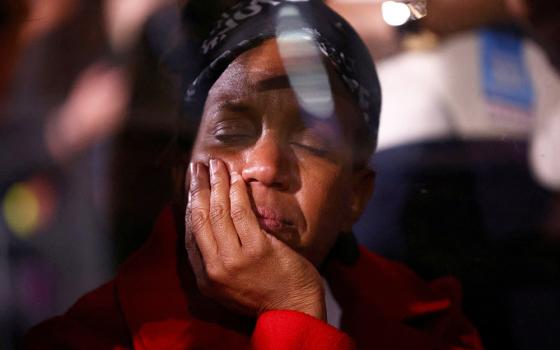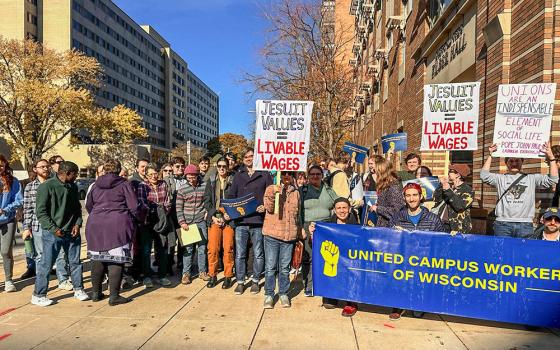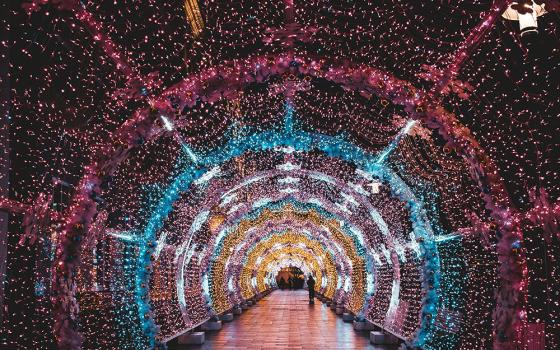
The Armenian Church of the Holy Cross on Akdamar Island, Lake Van in Turkey (RNS/Tania Karas)
This tiny Kurdish village outside the city of Van in Turkey's southeast is home to the ruins of a once-famous 11th-century Armenian Christian monastery.
Known to Armenians as Varagavank, it thrived as a place of worship until Turkish forces looted it and murdered parishioners in the mass killing sprees of 1915.
Today, the roof is collapsing. Toppled stone columns lie nearby. And with no signage, there is no acknowledgment it was once a celebrated church for Armenians.
Varagavank is one of hundreds of disappearing physical reminders of a community whose history in present-day Turkey goes back more than 2,000 years. Over the past century, the Turkish government, in writing its own narrative of what Armenians call genocide, has destroyed many Armenian churches, homes, schools and cemeteries or allowed them to fall into ruins. They are sites other countries might consider valuable antiquities.
"The term we use for this is 'cultural genocide,'" said Vahram Ter-Matevosyan, a historian at the American University of Armenia in Yerevan, Armenia's capital. "We consider what is happening to many churches a continuation of the genocide which started at the beginning of the 20th century. It is painful, utterly painful."
Historians and visitors have noted holes in the ground of Armenian historical sites throughout Turkey, evidence of widespread rumors that Armenians buried their riches before fleeing.
Hermine Sayan, an Armenian who lives in Istanbul, said her heart was broken when she visited what remained of a destroyed church in Malatya, a city in eastern Turkey, a few years ago.
"We stood together saying our prayers, and we were crying," said Sayan, whose grandparents survived the genocide.
On Friday, Armenians worldwide will commemorate 100 years since almost 1.5 million of their ancestors died in the last days of the Ottoman Empire, in massacres, by starvation or during forced death marches into the Syrian desert.
The date marks a century of fierce disagreement between Armenia and Turkey over what happened that spring. Armenians and their supporters -- including many historians, Pope Francis and the European Parliament -- say the murders constitute a systemic elimination of their population from eastern Anatolia in present-day Turkey.
But Turkey rejects the genocide label, saying hundreds of thousands of both Turks and Armenians died in battles between Ottoman and Russian forces in World War I. In a move that disappointed Armenians, the White House on Tuesday announced that President Barack Obama would not use the word "genocide" to describe the deaths despite his 2008 presidential campaign promise to do so.
Preservation and respect of Armenian history, culture and monuments in Turkey is a critical step toward Turkish-Armenian reconciliation, said George Aghjayan, an Armenian-American from Westminster, Mass., who studies Armenian demographics in Turkey and its environs.
"We have a right to our presence on this land," said Aghjayan, who plans to visit former Armenian villages and ruined sites in Van this weekend. "It's where our people were born, and it shouldn't be devoid of any evidence of their presence."
Van, located on Lake Van's picturesque shores, was once the capital of Vaspurakan, the first and biggest kingdom of greater Armenia. Van was also where, in 1915, Armenians saved thousands of their own when they held back the Ottoman army from city walls for a month. Resistance leaders who survived the siege founded the Armenian republic.
The Van Museum, however, offers a different take on regional history. One exhibit shows the "massacre [of Turks] undertaken by the Armenians during the occupation of Van in 1915 by the Russian troops," according to the Turkish Ministry of Culture and Tourism's website. (The museum was damaged in a 2011 earthquake and is being rebuilt.)
Present-day Van is part of unofficial Turkish Kurdistan. No Armenians are left; Turkey's 60,000 remaining Armenians mainly live in Istanbul. But Van and nearby villages contain what are known as Turkey's "hidden Armenians," descendants of women and children who converted to Islam after they were adopted by sympathetic neighbors or forced into marriage. Some are upfront about their origins, said Ferzan Demirtas, a tour guide in Van. But others stay silent, still fearful after a century of living as Kurds or Turks.
Cengiz Aktar, a scholar of Armenian-Turkish relations with the Istanbul Policy Center, argues that the Turkish attitude toward its Armenian minority is shifting. Aktar studies the politics of memory, or the influence of politics in how collective remembrances take shape.
"The real memories are undertaken by Turkish society," Aktar said, adding that Turkish citizens are increasingly exploring the truth behind what they learned in school.
Turkey's attempt to rewrite history is evident in Yemislik, another village outside Van, where Turkish officials replaced a former Armenian monastery with a mosque. But Van is perhaps best known for the Armenian Church of the Holy Cross on Akdamar Island in Lake Van. It is one of the only Armenian churches restored by the Turkish government, though it operates as a state museum.
On the eve of its reopening in 2007 after nearly a century of disuse, Turkish officials balked at placing a cross on the church's dome. They relented after a few years.
So far, Turkish promises to restore other sites have gone unfulfilled, leaving some to ponder whether Armenians of the diaspora should pitch in. Aghjayan, however, questions the logic of asking Armenians to pay for restoration of churches and villages from which their ancestors were displaced.
"What kind of justice is that?" he asked.



